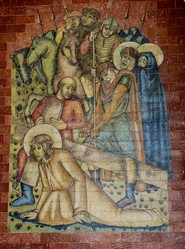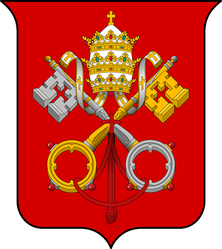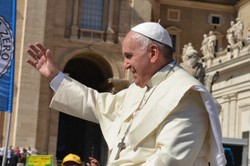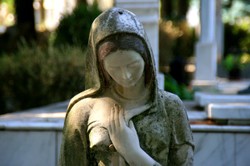"Solvitur Ambulando!" the Romans used to say. This means "It is solved by walking." Taking a walk to think out a problem is therefore a time-honoured strategy. There is something about walking that is conducive to reflective thought. When at theological college in Ireland I used to walk out at night to reflect on philosophical questions, and these times were, I believe, the most productive study periods. Many pilgrimages still involve long walks. For example, the pilgrim route to what is said to be the shrine of St James at Compostella, in Spain, is still walked by many pilgrims. Called the Camino de Santiago, it involve a long walking route of 30-35 days at 14-16 miles per day. A month on foot with much time for reflection. The pilgrim route to Canterbury, now being revived, involved walking down to that great cathedral and the shrine of Thomas a Becket, destroyed by England's greatest vandal, Henry the Eighth.
Of course, walking is an option. The Lourdes pilgrimage has never been a walking journey, and it has inspired the creation of the jumbulance, a coach turned into an ambulance for the sick and their young helpers, the handmaids and brancardiers, who tend them. Handmaids do the nursing tasks of feeding and cleaning; brancardiers do the heavy tasks, such as lifting the sick.Pilgrimages to Jerusalem often involved sea journeys,as must pilgrimages to the sacred isle of Iona in the Hebrides in Scotland, where St Columba lived and worked. As a youngster, when we took a trip to St Winefride's Well, in North Wales, my mother's favourite shrine, we took the bus. The shrine of Our Lady in Walsingham is visited by coach, but the trip concludes with a procession, a memory of the old walking tradition of the shrine.
Some pilgrims make all or part of the journey barefoot, as a sign of penance for their sins.My Irish mother-in-law, Kitty, whose girlhood home was not far from the great shrine of Our Lady of Knock, where Mary was seen by Irish peasants, used to walk to the shrine barefoot on August 15th, the feast of the Assumption of Mary into heaven. She would join the thronging crowds of villagers and farmers, women, men and children, to arrive at the basilica [important church not a cathedral] where they would attend mass in celebration of the feast.The barefooted tradition is still upheld in County Mayo, where Knock is situated, for once a year some pilgrims still climb stony Croagh Patrick barefoot in honour of the patron saint of Ireland.
The journey to the shrine should be a time of reflective thought when believers think about their lives, how well they are living and their relationship with God.For mediaeval pilgrims to Walsingham there used to be way stations, chapels where pilgrims attended services. One chapel survived the Reformation, the Slipper Chapel, where pilgrims left their shoes to walk barefoot the final mile,.and after centuries of disuse was restored as a place of worship.The journey on foot is therefore a journey of the soul, a stage in the soul's journey to God, a time for spiritual improvement.








 Pilgrimage. A review29 days ago
Pilgrimage. A review29 days ago
 Leo the Fourteenthon 05/09/2025
Leo the Fourteenthon 05/09/2025
 The Melsonby Hoardon 03/25/2025
The Melsonby Hoardon 03/25/2025




Comments
I cannot think of such a failure to follow precedent.
Thank you for your comment below, in answer to my previous observation and question.
The "usually" in your answer intrigues me.
Is there any well-known example of a pope not following precedent?
No. But it is usually the case that popes follow precedent.
Thank you for your comment below, on Apr 27, 2022, in answer to my previous observation and question.
The Holy Family Trail intrigues me.
Is the papal successor to Pope Francis compelled to continue or maintain something blessed and ratified by his predecessor?
I don't know how it is doing. Sorry.
Revisiting your wizzley brought to mind something that I'd meant to contribute after the first reading.
How is the Holy Family Trail, blessed and ratified by Pope Francis October 2017, doing as a pilgrimage? Internet articles mention Coptic beliefs in the Holy Family route as Bethlehem through North Sinai, to what is modern-day Cairo, the Delta, Wadi Natrun and south to Upper Egypt. It seems like that's the way the route is going/will go.
Yes, trekking to midnight mass has something of the character of a pilgrimage. However, for me church is a mere quarter of a mile away. But I attend the day time mass at Christmas now. I have found that nowadays I need to get to bed earlier than I used to, and where we are December nights are quite cold.
Nine churches in a day is a pilgrimage combined with a novena. A good idea.
Hi Frank,
This is a nice piece. One pilgrimage in this area was, and still is albeit more difficult, to visit nine churches on Good Friday. The Catholic population is large enough that neighboring parishes are close, and several had multiple churches for people of different nationalities. Today several churches are closed, or only opened on special occasions such as weddings. This is a result of the shortage of priests, and a society becoming more secular.
Indeed, families who trek to Midnight Mass on Christmas could be considered on a pilgrimage, although not at the level described in the article.
I read this hours ago, but had too little time to write a comment. Sorry about the delay.
Pilgrims retrieved slippers, otherwise the journey home would have been uncomfortable.
My mother was fascinated by the history of English Catholicism in the penal period, and as the shrine stayed in Catholic hands throughout the period she was specially attracted to it. Anyway, it was not far from where we lived or where we took holidays. We are from the North West of England, which is not far from North Wales, where the shrine is situated.
frankbeswick, Thank you for the practical informations and product lines.
As I mentioned elsewhere, my favorite Marian appearance is Knock: how blessed your wife and her family must feel to call that area home. My second is Fatima (pronounced FAH-tchee-muh in my carioca, Rio de Janeiro-accented Brazilian Portuguese), so I particularly value what your son says about the special beauty of Our Lady Mary still there.
But I wonder whether the owners abandoned their slippers or retrieved them on the way back from the Slipper Chapel; and why St Winefride's Well was your mother's favorite shrine (not that it wouldn't warrant that, just the particular one of many reasons).